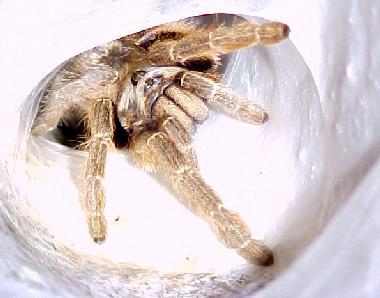
The small horn size of
this individual is apparent as she guards her eggsac. |
Greater Horned Baboon
Ceratogyrus sp. (aka
pet trade C. brachycephalus)
These are spiders from the
same subfamily as Pterinochilus spp. Like their cousins, they
grow quickly, web profusely, and prefer a somewhat drier habitat.
They are distinguished from other species of tarantula by a unique forward-facing
"horn" that arises from
the center of the carapace. Contrary to its namesake, different individuals
of C. brachycephalus may or may not have a very large horn; it may
be so small as to resemble the horn of C. sanderi, which is more
of a plug than a protuberance. Some hypothesize that the small-horned spiders
sold as C. brachycephalus in the pet trade might be C. sanderi
or
perhaps a hybrid (thanks to P. messenger of The
Tarantula Store for that
info).
Typical of the members of
the genus Ceratogyrus, this spider has a pale band on the underside
of its abdomen. |
|
Range: The Greaterhorned
Baboon comes from southern Africa, in Botswana and Zimbabwe.
Habitat: Semi-dry
scrubland
Size: Small for a
tarantula. Though I have seen specimens at over 5" in legspan, I
have successfully bred a female that was a mere 3 1/2" at maturity.
The male, which was mostly legs, was about 3" in span.
Attitude: Generally
quite defensive, but I have seen some healthy individuals that are much
less high-strung than others. I haven't come across a specimen that
would sit still for handling and most would bite if provoked enough.
Dwelling: They love
to dig, and they like to web even moreso! I've seen sub-spiderlings
just past the "eggs-with-legs" stage that began webbing a fair amount.
Once they molt into actual feeding spiderlings, there is no end to their
webbing endeavors.
Ideal Setup: A 2.5
to 5 gallon container with enough peat/potting soil for digging in (fill
it about 4-8 inches deep). Supply a water dish. They like it
somewhat dry, but moistening the soil or misting may be appropriate in
August/September to mimic the S. African wet season if desired. I've
noted that my female will not lay eggs in the summer if the substrate isn't
moist. Keep the temperature around 75-80 degrees F if possible.
Food: Any bugs that
haven't been exposed to pesticides (3-5 crickets a week for adults); baby
mice. Spiderlings love to eat and will take on prey their size quite
readily.

This is the post-molt coloration.
Note the patterning on the opisthosoma. |

The female on the left is not a large spider. Note the diminutive
size of the male in relation to her. |
© 2019. All
rights reserved.